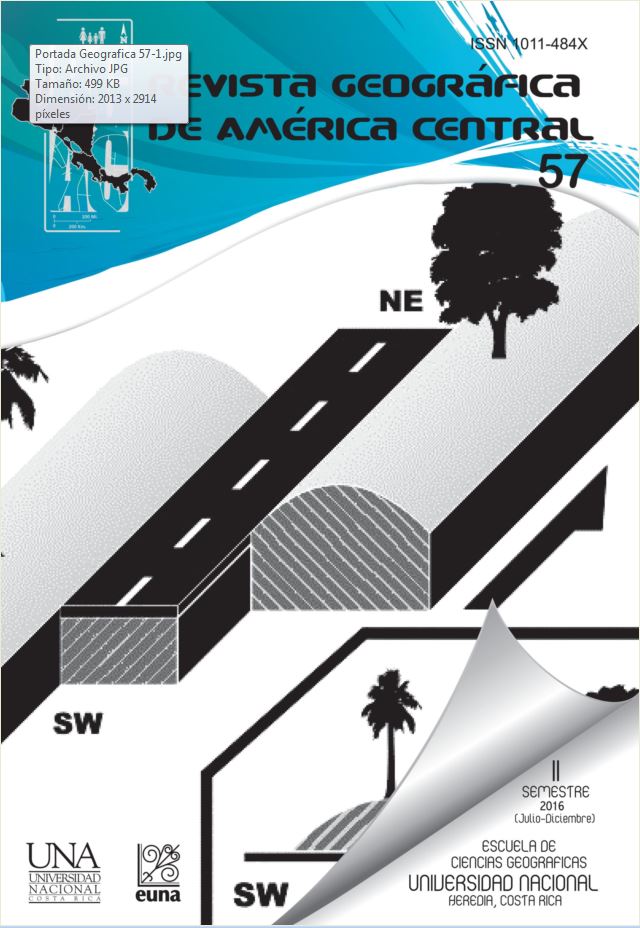PRIORITY MUNICIPALITIES FOR DISASTER RISK MANAGEMENT: A CONTRIBUTION TO THE DECISIONMAKING PROCESS
DOI:
https://doi.org/10.15359/rgac.57-2.1Keywords:
management, disaster risk, response, preventionAbstract
In case of a disaster, local governments are the first to help his community. However, they do not always have adequate resources to develop efforts aimed at preventing and responding to disastrous events. Thus, 25 priority municipalities for Disaster Risk Management, according to physical, social, and economic variables, considering the most common events that cause impacts in the population were identified. This prioritization will guide the efforts made by public services in the areas of disaster risk reduction, in order to execute effective, efficient, and timely actions.
References
Aquino, A. (2010). La Gestión del Riesgo en Procesos de Desarrollo Sostenible. En: Seminario Regional sobre Inversión Pública y Mecanismos Financieros, Seguros y Reaseguros contra Desastres en América Latina y el Caribe: Experiencias Recientes. Ciudad de México, México.
Brignardello, L. (1997). Proposición Metodológica para la evaluación y zonificación integrada de riesgos naturales mediante la aplicación de Sistemas de Información Geográfica. Revista Norte Grande, 24, 91-102.
Cardona, O. (2013). Modelación probabilística para la Gestión del Riesgo de Desastres. Bogotá, Colombia. Banco Mundial.
Castillo, M., Julio, G. y Quintanilla, V. (2008). Vulnerabilidad y Daño Potencial ocasionado por Incendios en Áreas e Interfaz Urbano – Forestal, Provincia de Valparaíso, Chile Central. Revista Territorium, 18, 247-257.
Centro Sismológico Nacional (CSN). Recuperado de: www.sismología.cl
Dirección Meteorológica de Chile. (2015). Recuperado de: www.meteochile.cl
Dirección de Gestión de Riesgo de Colombia. (2010). Guía Municipal para la Gestión del Riesgo. Bogotá, Colombia.
Estrategia Internacional de Reducción de Riesgo de Desastres. (2007). De las Palabras a la Acción: Guía para la Implementación del Marcode Acción de Hyogo. Panamá.
Lavell, A. (2004). Sobre la Gestión del Riesgo: Apuntes hacía una Definición. Biblioteca Virtual de Desarrollo Sostenible y Salud Ambiental. Recuperado de http://www.bvsde.paho.org/: 10 noviembre de 2014.
Lavell, A. (2007). Apuntes para una reflexión institucional en países de la Subregión Andina sobre el enfoque de la Gestión del Riesgo. Proyecto de Apoyo a la Prevención de Desastres en La Comunidad Andina – REDECAN
Lozano, O. (2011). Guía Metodológica para Incorporar la Gestión del Riesgo de Desastres en la Planificación del Desarrollo. Centro de Estudios y Prevención de Desastres. Recuperado de http://www.predes.org.pe: 10 de diciembre de 2014
Manandhar, R. y McEntire, D. (2014). Disaster and Development, Chapter 2 “Disasters, Development, and Resilience: Exploring the Need for Comprehensive Vulnerability Management”. Texas, Estados Unidos.
Madariaga, R. (1998). Sismicidad de Chile. Revista Física de la Tierra, 10, 221-258.
Ministerio de Medio Ambiente. (2008). Plan Nacional de Adaptación al Cambio Climático. Santiago, Chile.
Ministerio de Medio Ambiente (2007). Estudio de Variabilidad Climática en Chile para el Siglo XXI. Santiago, Chile.
ONEMI. (2014). Política Nacional para la Gestión del Riesgo de Desastres (PNGRD). Chile.
Quintanilla, V. (1983). Biogeografía de Chile. Instituto Geográfico Militar. Chile.
Subsecretaria de Desarrollo Regional y Administración – SUBDERE (2010). Plan Regional de Ordenamiento Territorial. Santiago, Chile.
Subsecretaria de Desarrollo Regional y Administración – SUBDERE (2011). Identificación de Territorios Aislados. Santiago, Chile.
UNISDR. (2010). Diagnóstico de la Situación de la Reducción del Riesgo de Desastres en Chile.
UNISDR. (2015). Global Assessment Report (GAR)
Downloads
Published
How to Cite
Issue
Section
License
Proposed policy for journals offering Open Access
Authors publishing their works in the Journal acknowledge and agree to the following terms:
a) Authors retain the copyrights to their works and guarantee the Journal the right to be the first to publish their works, under the Creative Commons License Attribution-NonCommercial-ShareAlike 4.0 International, CC BY-NC-SA 4.0 International (https://creativecommons.org/licenses/by-nc-sa/4.0/deed.es), which allows others to share works upon complying with the acknowledgment of authorship and mention of the Journal as the original publisher of the work.
b) Authors are permitted to separately establish additional agreements for the non-exclusive distribution of the official edition of the work published in the Journal (for example, authors may desire to place the work in an institutional repository or incorporate it into a book that is to published elsewhere) so long they acknowledgment to recognize the Journal as the original publisher. The aforementioned additional agreements must respect the terms of the non-profit character and sharing philosophy of the original license (CC BY-NC-SA 4.0 International, https://creativecommons.org/licenses/by-nc-sa/4.0/deed.es).
c) Authors are encouraged to archive the post-print or editor/PDF version in Open Access repositories.






 REVGEO is licensed under https://creativecommons.org/licenses/by-nc-sa/4.0/deed.es
REVGEO is licensed under https://creativecommons.org/licenses/by-nc-sa/4.0/deed.es
.svg_4.png)

_(1).png)
_(1)_(1)_(1)_1.png)
(2)(1)(1)(1).png)
